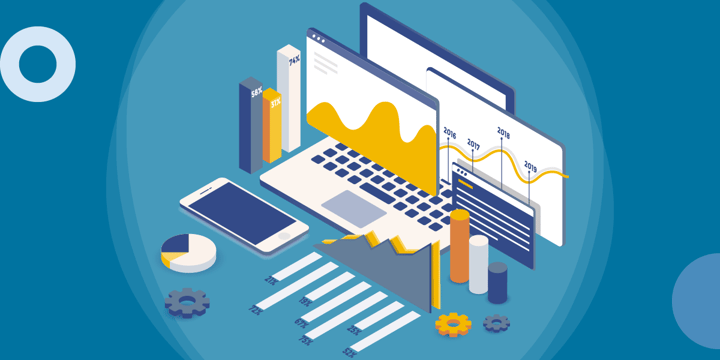According to a study conducted by Statista in the U.S. and Canada, "donor cultivation, acquisition, retention, and communications" is ranked the second biggest challenge faced by nonprofits, second only to concerns about staffing.
Fundraising is increasingly competitive with government budget cuts, a wealth of worthy causes to give to, and difficulty engaging donors given the way they consume content with new technologies. That's something that has anecdotally increased since the COVID-19 pandemic.
To gain an edge in today's cluttered fundraising environment and achieve long-term sustainability, it's imperative that nonprofits use data effectively to guide their fundraising strategies, especially when the nature of fundraising, including fewer in-person events, has changed. Here are a few practical tips for leveraging data to drive fundraising results.

Create a Data-Driven Culture
Above all, nonprofits need to create a culture that values data-driven decision-making. Leadership should demand quantitative and qualitative analysis of how past fundraising efforts perform and use the results to inform future outreach. The staff should understand the importance of making evidence-based decisions and should be trained on the basic vernacular of fundraising key performance indicators (KPIs). Those who are on the ground running fundraising efforts should establish a test-and-learn process to optimize the ROI on new initiatives.
Identify Relevant Fundraising KPIs
The peril of being in the "big data" age is never the lack of data, but rather having too much data and not knowing how to use it. Nonprofits need to figure out the metrics that truly matter to their organization and relentlessly measure against them. There are four categories of fundraising KPIs:
- Funding KPIs: These are numbers that directly reflect how much money has been raised, such as donations received year-over-year, the average gift size, percentage of recurring gifts, and percentage of contributions matched through corporate philanthropy.
- Donor KPIs: To maximize your fundraising results, you need to keep a regular check on who your donors are and how they change over time. For example, pay attention to
- Demographic breakdown
- Donor retention rate: those who have given more than once
- Lifetime value and giving capacity
- Donor journey mapping, such as how long it takes to convert a prospect or to solicit a second gift from the same donor
- Channel KPIs: Nonprofits should adopt an omnichannel strategy to meet where their donors are and measure the effectiveness of the channels used, be it email, social media, or online events. Examples include email open and conversion rates and social media amplification rate (shares, retweets, and so on).
- ROI KPIs: Ultimately you need to understand the return on investment (ROI) for fundraising to inform future strategies. For example, what is the cost per dollar raised, the cost of acquiring and retaining a donor over their life cycle, and the cost per campaign.
There are many metrics to consider — it's important to be thoughtful about determining what to measure upfront so the data can have a real impact on improving your fundraising efforts.
Avoid Pitfalls in Managing and Using Data
In collecting, managing, and applying data to drive fundraising strategies, there are several common pitfalls that nonprofits should watch out for.
- Data is not well organized: Data may exist in different places, such as manual records, Excel, and email management software. This can create a huge barrier to synthesizing data to tell a holistic story. To make matters worse, nonprofits may not have proper protocols in place to regularly clean up duplicated or outdated data, severely limiting its rigor and usefulness. It's worthwhile considering a comprehensive donor database software to track all relevant data and oversee fundraising efforts. You should also make a point to set up clear data entry guidelines and clean up your data on a regular basis.
- There is a confirmation bias: Seeking out data to validate preexisting assumptions is called confirmation bias. It may be easier said than done, but putting personal bias aside and being open to whatever the data may say is a prerequisite for deriving any potential benefits from the data. You may have the best data you can possibly gather, but without the right mindset to approach this properly, you could risk making erroneous decisions and wasting precious resources.
- All metrics are treated equally: Different fundraising goals call for different metrics. Depending on what you're looking to achieve, it's advisable to customize KPIs for a given campaign. For instance, if your goal is to raise more money, you will want to understand donor KPIs, such as their giving history and background information. If your goal is to better engage your donors, you will want to pay careful attention to channel KPIs such as email open rates and direct mail response rate. What's more, with social media being an integral part of our daily life, weeding out vanity metrics such as "likes" on a post and focusing on actionable metrics is becoming increasingly important.
Fundraising success hinges upon developing a data-driven strategy, having an effective execution plan, and being agile enough to revise campaign strategies based on data along the way. Nonprofits should also refine this feedback cycle over time, reassessing what to measure and how to measure according to what drives the best results. Organizations that have cracked the code on using data to inform their fundraising strategies will be able to differentiate themselves from the rest and be successful in the long run.
Additional Resources
- Take related TechSoup Courses training:
- Take advantage of TechSoup's Digital Marketing Services.
- Learn how to Boost Your Nonprofit's Fundraising with TechSoup's Product Donations and Discounts.
- Get your Data Just Right.
- See a webinar on How to Be a Data-Driven Organization with Power BI.








